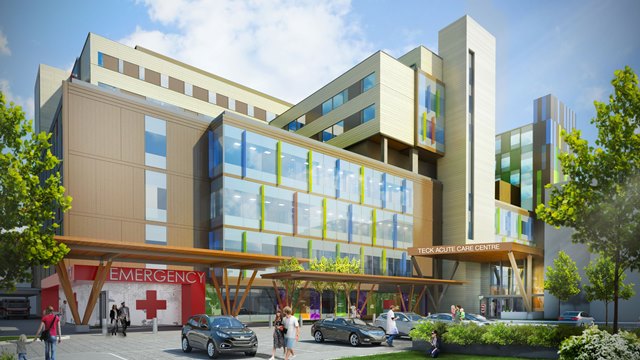
The new Teck Acute Care Centre in Vancouver will be a leading example of how sustainability in healthcare makes sense not only for the environment and operating budgets, but even more significantly for patient care.
The new facility has been designed to meet or exceed Canadian Leadership in Energy and Environmental Design (LEED) Gold standards and is currently under construction at BC Children’s Hospital and BC Women’s Hospital + Health Centre.
MORE: THE DIGITAL HEALTH REVOLUTION
The project is an initiative of the Provincial Health Services Authority (PHSA) – one of several health authorities in British Columbia that support green initiatives (www.bcgreencare.ca). PHSA is committed to sustainability and has adopted a “triple-bottom-line” policy that balances ecological, societal and economic priorities within the health-care context.
The Teck Acute Care Centre will incorporate energy reduction strategies that will result in significant, long-term operational cost savings. These include a high-performance lighting strategy that uses appropriate daylight, dimming and high-efficiency fixtures and thermally efficient, durable and low-maintenance exterior walls. It will also feature green roofs will also reduce storm water run-off, windows that reduce conductive heat loss during the winter and low-flow plumbing fixtures and other water-saving equipment.
“Economically sustainable environments are those that reduce the amount of time, energy and cost to maintain them, thereby making a positive impact to the bottom line,” says Eleanor Lee, Senior Director of Design and Implementation for the BC Children’s and BC Women’s Hospital Redevelopment Project. “At first glance, energy efficient building products may be more expensive, but once operating cost savings are factored in, the overall long-term savings more than offset the initial higher cost.”
But the benefits of the facility’s sustainable design will extend beyond economic savings to reflect social sustainability and a patient- and family-centred philosophy of care – two approaches that often go hand-in-hand. A healing and nurturing environment is key element of social sustainability and inherently important to a facility that strives to improve the health and wellness of its community.
MORE: MAKING THE CUT: REDUCING THE RISK OF SURGICAL SITE INFECTIONS
“Environmental sustainability touches all parts of the building inside and out and is an integral part of the design,” Lee says. “We are in the business of health and what better place to demonstrate this than in a healthy building.”
Every patient room will have windows that let in daylight and have views to the outside. Indoor and outdoor play spaces for children will act as positive distractions, and family lounges with laundry and entertainment facilities will help support the family.
The landscape design for the site also includes a Wellness Walkway that will encircle the entire hospital campus. The walkway is intended to assist in the healing of patients and contribute to the physical and mental health of staff, visitors to the hospital and those living in the surrounding communities. It will allow different individuals to find comfort in a variety of environments, including secluded contemplative spaces and open social spaces.
Drought-resistant, native plants will be used throughout the site to help reduce maintenance efforts and costs, and several rain gardens are planned along the walkway to capture storm water that will not only reduce pollution, but also create a calming environment that replicates natural systems.
MORE: INCREASING YOUR FACILITY’S WATER EFFICIENCY
The colours and textures of the new centre will also help connect patients to nature and improve the overall healing environment. The design elements of the windows and interiors will reflect those found in the forest, starting with the colours found on the forest floor, moving up through the canopy to blue sky, and the centre will also include the use of wood in the interior and exterior of the building.
“Green design not only helps reduce the costs of maintaining a facility, it has a positive impact on our patients and families and helps save the planet for the next generation,” Lee says.
Construction of the new Teck Acute Care Centre began in the spring of 2014 and will be completed in 2017.

